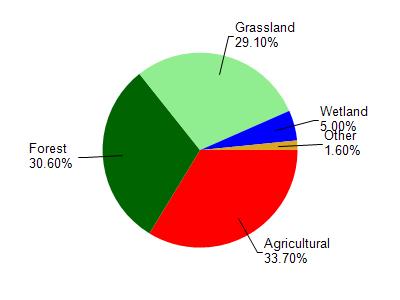St. Croix
Yes
No
No
Fish and Aquatic Life
Overview
The upper 5.4 miles of this creek are a Class I trout fishery with abundant natural brook trout
reproduction. The next 12.6 miles are managed as a Class I1 trout fishery. Portions of the stream are
affected by streambank erosion, ditching, streambank pasturing, and elevated water temperatures.
Tiffany Creek is occasionally degraded by urban runoff and fertilizer spills in Glenwood City. The
upper two miles of the Class II section of this creek may be improved to Class I status with
reductions in nonpoint source pollution (Schreiber).
The Glenwood wastewater treatment plant discharges to a natural wetland draining into Tiffany
Creek. A portion of the headwater area is classified as a variance water for limited aquatic life. It is
uncertain if ammonia standards are being met in Tiffany Creek (LaLiberte). Allied Processors Inc.
has a permit to discharge to Tiffany Creek, however it ceased the discharge in late 1994. The
company intends to discharge to Tiffany Creek only in emergency situations.
Date 1996
Author Aquatic Biologist
Historical Description
Tiffany Creek Flows east into Dunn County and the Hay River drainage system. Of the stream's 4.2 miles length, 2.4 miles of the lower portion near Dunn County are trout water; brook trout are common here. A forage-minnow feeder stream, 1.3 miles long enters Tiffany Creek from a sedge-cattail marsh in Section 26. An artificial impoundment (3 foot head) is located at its headwaters and is used as a swimming pool in Glenwood City. An 8-acre marsh wetland area provides habitat for muskrat. A Girl Scout maintained wayside park is situated on Tiffany Creek just off County Highway 128. Public access to this stream may be had from four road bridges. -T30N, R15W, Sec. 34 to T30N, R15W, Sec. 25. Surface Acres = 2.0, Miles = 4.2, Gradient = 15 feet per mile
From: Sather, LaVerne M. and Threinen, C.W., 1961. Lake and Stream Classification Project. Surface Water Resources of St. Croix County, Wisconsin Department of Natural Resources, Madison, WI.
Date 1961
Author Surface Water Inventory Of Wisconsin
General Condition
Tiffany Creek (WBIC 2070500) was assessed during the 2018 listing cycle; new biological (macroinvertebrate and fish Index of Biotic Integrity (IBI) scores) sample data were clearly below the 2018 WisCALM listing thresholds for the Fish and Aquatic Life use. This water was meeting this designated use and was not considered impaired.
Date 2017
Author Ashley Beranek
Condition
Wisconsin has over 84,000 miles of streams, 15,000 lakes and milllions of acres of wetlands. Assessing the condition of this vast amount of water is challenging. The state's water monitoring program uses a media-based, cross-program approach to analyze water condition. An updated monitoring strategy (2015-2020) is now available. Compliance with Clean Water Act fishable, swimmable standards are located in the Executive Summary of Water Condition in 2018. See also the 'monitoring and projects' tab.
Reports
Management Goals
Wisconsin's Water Quality Standards provide qualitative and quantitative goals for waters that are protective of Fishable, Swimmable conditions [Learn more]. Waters that do not meet water quality standards are considered impaired and restoration actions are planned and carried out until the water is once again fishable and swimmable
Management goals can include creation or implementation of a Total Maximum Daily Load analysis, a Nine Key Element Plan, or other restoration work, education and outreach and more. If specific recommendations exist for this water, they will be displayed below online.
Monitoring
Monitoring the condition of a river, stream, or lake includes gathering physical, chemical, biological, and habitat data. Comprehensive studies often gather all these parameters in great detail, while lighter assessment events will involve sampling physical, chemical and biological data such as macroinvertebrates. Aquatic macroinvertebrates and fish communities integrate watershed or catchment condition, providing great insight into overall ecosystem health. Chemical and habitat parameters tell researchers more about human induced problems including contaminated runoff, point source dischargers, or habitat issues that foster or limit the potential of aquatic communities to thrive in a given area. Wisconsin's Water Monitoring Strategy was recenty updated.
Grants and Management Projects
| Project Name (Click for Details) | Year Started |
|---|
|
|
Monitoring Projects
| WBIC | Official Waterbody Name | Station ID | Station Name | Earliest Fieldwork Date | Latest Fieldwork Date | View Station | View Data |
|---|
| 2070500 | Tiffany Creek | 10011863 | Tiffany Creek - 13-Tiffany Creek. 50' U.S. Of Confluence Of South Tiffany | | | Map | Data |
| 2070500 | Tiffany Creek | 10010776 | Tiffany Creek - Tiffany Creek 12 320th St. | 1/1/2015 | 1/1/2015 | Map | Data |
| 2070500 | Tiffany Creek | 563096 | Tiffany Creek at 320th Ave. Bdg | 1/5/1995 | 12/7/1995 | Map | Data |
| 2070500 | Tiffany Creek | 10012744 | Tiffany Creek 13b ~250 Meters Downstream Of South Fairgrounds Drive | | | Map | Data |
| 2070500 | Tiffany Creek | 10012745 | Tiffany Creek 13c | | | Map | Data |
|

Watershed Characteristics
Tiffany Creek is located in the South Fork Hay River watershed which is 181.99 mi². Land use in the watershed is primarily agricultural (33.70%), forest (30.60%) and a mix of grassland (29.10%) and other uses (6.60%). This watershed has 399.14 stream miles, 412.20 lake acres and 6,405.93 wetland acres.
Nonpoint Source Characteristics
This watershed is ranked Not Available for runoff impacts on streams, Not Available for runoff impacts on lakes and High for runoff impacts on groundwater and therefore has an overall rank of High. This value can be used in ranking the watershed or individual waterbodies for grant funding under state and county programs.However, all waters are affected by diffuse pollutant sources regardless of initial water quality. Applications for specific runoff projects under state or county grant programs may be pursued. For more information, go to surface water program grants.